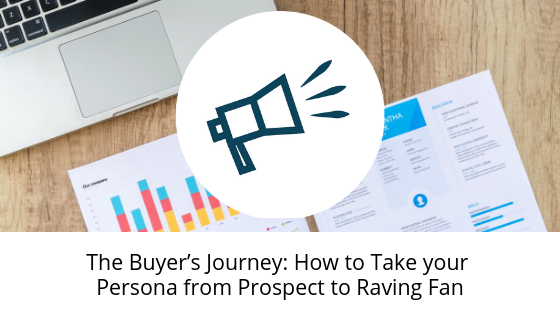Think of the steps you take prior to making a purchase. Do you see something once and buy it on a whim or do you take your time and investigate? With the exception of a few minor things, like gag gifts, purchases are well-thought out and carefully researched. Everyone wants to make sure they get the most bang for their buck by making a purchase they will be happy with for the long-term. We call this process of investigating before making a purchase the buyer’s journey.
The buyer’s journey is crucial to marketing your business, increasing leads, and closing sales. It’s three stages – awareness, consideration, and decision – nurture buyers through the sales funnel and turn website visitors to happy customers. Each stage requires different content and media to work effectively. Here is a breakdown of the key pieces of each stage:
Awareness
“Hmm. I’m not generating any leads for my business. What should I do?”
In the awareness stage, people are aware they have a problem or a need for something. However, they aren’t ready to decide how to solve the problem or what purchase to make because they don’t have enough information to act. Instead, they are researching more into their need or problem to gather more information and hopefully be better prepared to find an effective solution.
That’s where you come in! The key thing to remember is content created for people in the awareness stage should be educational. You can’t try to sell them your product if they have just identified they have a problem and are perusing their options. Instead, you are trying to give them the educational information they are looking for, which will establish trust and credibility.
Some effective types of content for this stage include:
-
Blogs
-
Social media
-
Ebooks
-
Whitepapers
-
Reports
-
One-sheet
-
Informational webinar
-
Instructional video
Whatever type of content you choose should be full of answers, data, opinions, and insights into the buyer’s problem only. You should vary the types of media, the topics, and how you promote it, so you can create an arsenal of content, become an industry leader, and move potential buyer’s through the buyer’s journey.
However, rather than just pumping out content like a machine, these educational materials should be well-thought out and written with the buyer’s goals and challenges in mind rather than what you want them to know. This content isn’t for you. It’s for them. That means you need to take a second, put yourself in the buyer’s shoes, and think about the best topics and media types.
Questions to ask yourself before creating a piece of content include:
-
What are the buyer’s goals and challenges?
-
What type of medium would be most beneficial for addressing the buyer’s goals and challenges?
-
Are there any misconceptions or mistruths about the buyer’s goals and challenges?
-
What pieces of information are most important for educating the buyer about their goals and challenges?
-
How much of a priority is this goal or challenge to the buyer?
-
Will inaction on these goals and challenges result in any consequences?
These questions are crucial for generating content buyers in the awareness stage are searching for, because they turn the focus to the buyer, not to selling the product. Fight the instinct to throw a pitch about your company or product into each piece, and instead, lend a helping hand to buyers just beginning their journey. Remember, successful awareness stage content is educational and informational and focuses on the buyer – not you. If there’s one thing to take from this blog, it’s that.
Consideration
“It looks like marketing is a good way to increase leads. But what type of marketing should I use?”
During the consideration stage, the buyer has identified his or her goal or challenge and decided it is time to find the solution. They shop around, looking for the different approaches or methods available and weighing the pros and cons of each. If you successfully caught their attention during the awareness stage, they are checking out your content in the consideration stage because you are a contender!
Unlike the awareness stage, content created for the consideration stage educates people about your company and services. You no longer need to provide general information that is non-specific to you. This is when your product or service is under the most scrutiny from the buyer, so it’s important to showcase your offerings and explain why you’re the best.
Some effective types of consideration stage content include:
-
Product webinar
-
Client case study
-
Statistics sheet
-
Demo videos
-
Product FAQs
-
Product comparison
Regardless of what type of content you pick, it should be created in an honest way. Sure, you want to show that your product is the best one for buyers, but you don’t want to make claims you can’t back up. And, this is very important, you don’t want to attract buyers who aren’t good fits for your company. I know it’s hard to accept there are some people you shouldn’t take money from and offer your services to, but it’s the truth. Once you understand that and produce content that is honest, you will get more effective leads and decrease client turnover.
Before you start curating these pieces of content, you need to once again put yourself in the buyer’s shoes. However, because you aren’t trying to sell to customers who aren’t a good fit, the questions you need to ask are very different. Instead, you need to focus on the different methods and approaches available.
With your buyer personas in mind, questions to ask yourself before you create a piece of consideration stage content include:
-
What are the different approaches or methods to solving the buyer’s problems?
-
How will buyers educate themselves on each approach?
-
What are the pros and cons of each approach?
-
How do buyers decide what approach is right for them?
By asking yourself these questions, you can more effectively compare and contrast the different options available to the buyer and help him or her decide if your product is a good fit. If so, you need to establish trust between the buyer and your brand. Sometimes, the buyer is looking for information that business owners don’t want to publish, such as prices and comparisons to competitors. Fight that feeling! If you do not write content on what the buyer wants because it makes you uncomfortable, someone else will!
Decision
“Digital marketing seems to be the most effective way to increase leads.”
All the buyer’s research and investigating comes to fruition during the decision stage. Now, they are ready to pull the trigger and make a decision to buy a particular product. They are aware of what solution category they need and are trying to decide what company within that category they should buy from. They may know what company they’d like to work with, but they need to educate themselves more on what being a customer from your company requires.
Content created for the decision stage should welcome potential customers with open arms, showing them you and your product are easy to use and within their price point. They are at the bottom of the sales funnel at this point, so they just need a final nudge or enticing call-to-action to go from lead to new customer.
Types of content for the decision stage include:
-
Live demos
-
Free trial
-
Coupon
-
Freebies
-
Estimate
-
Evaluation
-
Consultation
The key is to establish a stronger relationship that is built on trust. You’ve made it through the first two stages of the buyer’s journey, which is arguably the toughest part, so don’t overthink it! Buyers know your product is great and may only need you to sweeten the deal.
To ensure you make the correct final push to buyers, you need to ask yourself questions to identify the most enticing things about your product and build a piece of content around it. Again, think like you are the potential buyer and determine what you’d need to be convinced to buy a product.
Questions to ask yourself before content creation in the decision stage include:
-
What will buyers like about your company’s product when compared to alternatives?
-
What will buyers dislike about your company’s product when compared to alternatives?
-
What criteria will buyers have when picking a product?
-
What hesitations will buyers have about purchasing your product?
-
Who needs to be involved in the decision making?
-
What will each person in the decision making process be looking for in a solution?
-
Is there any require preparation or steps before implementing a solution?
Because there are different people involved in the decision making process, the most enticing thing about your product may be different from one person to another. Ask yourself the questions above from the standpoint of each persona you have for your company, and you will more effectively close sales and increase customer retention.
While this may seem like an overwhelming amount of information, it’s only the tip of the iceberg when it comes to the buyer’s journey and inbound marketing. For a more complete look into how the buyer’s journey correlates to inbound marketing as a whole, check out our Marketing 101 seminar. Get more information and sign up here.


Recent Comments